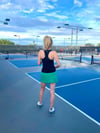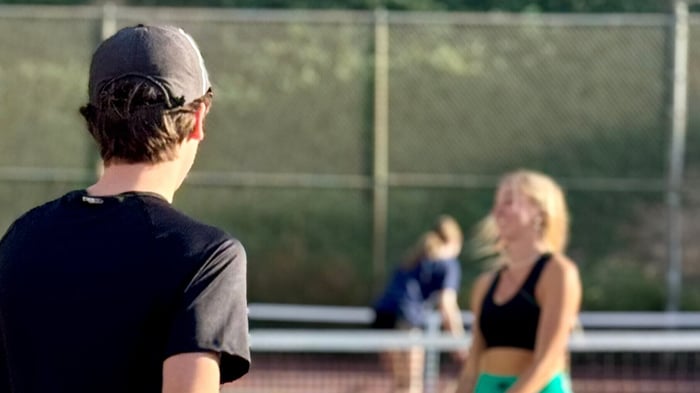Key takeaways:
You can legally hit the ball with your paddle hand, but only below the wrist and only if it’s holding the paddle.
The ball must bounce cleanly off your hand—it can’t be caught, carried, or redirected unnaturally.
Training hand positioning and reflexes boosts control during fast exchanges and tight net play.
Fast pickleball rallies lead to all kinds of unexpected hits—including times when the ball hits your paddle hand instead of the paddle. Should that still count as a legal shot? It’s one of those common moments that catches players off guard and brings up questions mid-game.
This situation, in particular, has more nuance than most realize, and understanding pickleball rules related to it can help you stay calm and confident when it happens. At PB5star, we’re here for players who want to sharpen every part of their game—rulebook knowledge included.
The only time hand contact is legal in pickleball
So, can you hit a pickleball with your hand/ The official pickleball rules make a very specific allowance for hand contact during play: if the ball hits your paddle hand below the wrist while it’s in contact with your paddle, the rally can continue. So technically, yes—you can hit a pickleball with your hand under that condition.
This isn’t a move anyone’s aiming for on purpose. It usually happens by accident during fast volleys or tight net play. But knowing the rule helps avoid confusion or disputes when these quick moments pop up.
It’s also worth knowing that legal contact doesn’t mean you can grab or cradle the ball. It needs to bounce off your hand just like it would your paddle. These rules exist to keep the game fair and fast—not to encourage using your hand in place of a clean paddle hit.
Explore practical hand techniques
Smart handwork is a huge part of staying sharp on the court. Whether you’re setting up for a clean volley or adjusting mid-rally, how you position and move your hands can give you the edge in tight exchanges.
Here are some practical hand techniques to work into your training:
Relax your grip in the ready stance – A loose, controlled hold gives you quicker reaction time and makes it easier to reset between shots.
Watch for the “Seesaw Effect” – Named for the up-and-down motion of a seesaw, your opponent’s paddle angle reveals a lot. If it tips down, a hard drive is coming. If it tilts up, prepare for a soft drop shot.
Use the “Triangle Effect” – Mentally connect your stance, the ball, and possible return zones to build stronger court awareness. Those three points form a mental triangle that keeps your movement sharp.
Drill with solo wall work – Fast-paced wall returns and bounce drills help fine-tune your reflexes and coordination.
Track opponent habits – Pay attention to their go-to shots during volleys. The more you notice, the faster you can react in real-time.
Practice with a partner – Working on these skills together makes each drill more effective—and more fun.
Dialing in these techniques takes time, but the payoff shows up fast during competitive points. When your hands know what to do before you even think about it, you're better equipped to handle whatever the other side throws at you.
Your most asked pickleball questions answered
Pickleball is full of small details that can make a big difference in how you play. From gear choices to off-court practice routines, there’s always something new to figure out. Here’s a breakdown of some of the most common questions around technique and gear:
How can I improve when I don’t have court access?
Even without a court, you can still make real progress. Practice footwork patterns in an open space, try shadow swings to work on your form and add reaction drills to sharpen your reflexes. These off-court habits build the kind of muscle memory that shows up when you're back in a game.
Why is paddle work such a big deal in pickleball?
The paddle is what gives you control over both power and touch. Every shot depends on how you hold and move it. Even slight changes in grip can affect how the ball responds. That’s why the rules are so specific—catching or carrying the ball isn’t allowed, even if it looks smooth.
What if my paddle doesn’t feel right anymore?
Sometimes it’s just not the right fit. If your paddle feels too heavy, off-balance, or hard to control, it might be time to switch things up. Control paddles give you more feel for soft shots, while balance paddles help with consistent placement and solid power. It’s all about what feels natural in your hand.
What should I look for when updating my pickleball gear?
Start with the essentials: your paddle, your shoes, and what you’re wearing on the court. The right footwear makes a big difference in comfort and stability, especially during fast-paced movement and quick directional changes. Your gear should feel light, supportive, and ready for your style of play—no distractions, just solid performance where it counts.
Know more than just the basics
Digging into the finer points of pickleball rules helps you stay sharp and adaptable in any game situation. It’s not just about knowing the rulebook—it’s about using that insight to make split-second calls that keep you in control. When you understand what’s allowed and when, you open up new possibilities for smarter plays.
Whether you’re a weekend regular or chasing tournament wins, growing your rule knowledge is a solid move toward becoming a better player. At PB5star, we’re right there with players who value both style and strategy—where gameplay meets pickleball gear that matches your energy on and off the court.







